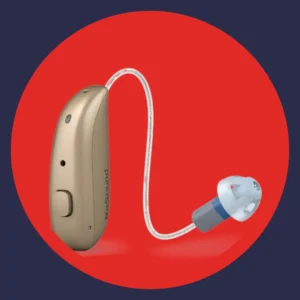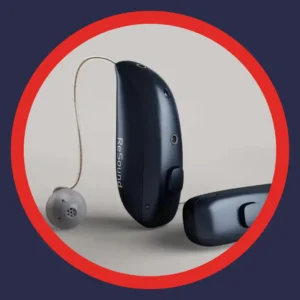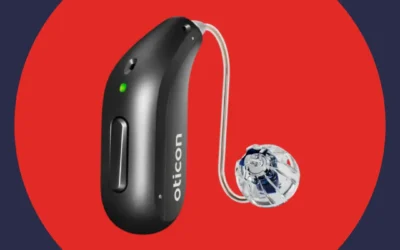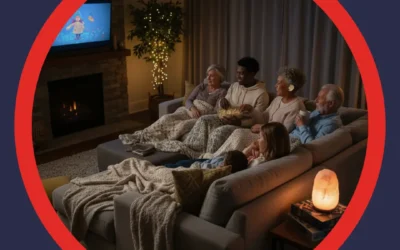ReSound Nexia Hearing Aids set a new benchmark when they arrived in late 2023. Compact, connected, and built for clarity, they made conversation in noise more natural than ever.
Now, the new ReSound Vivia takes that success further with Intelligence Augmented processing. Its Deep Neural Network was trained on real conversations to recognize voices and quiet the chaos around them—like a tiny sound engineer that never gets tired.
Hearing technology moves fast, and today’s devices feel light-years ahead of earlier models. You can discover the amazing features available in hearing aids today to see how innovations like adaptive focus, Bluetooth streaming, and AI-driven clarity have changed the game.
Next, let’s meet both models to see what sets them apart.

ReSound Nexia: Setting the Stage
When ReSound Nexia Hearing Aids launched in 2023, they brought an impressive mix of clarity and connectivity. The Nexia introduced Auracast-ready Bluetooth, a compact microRIE design, and ReSound’s 360 All-Around Directionality that helped listeners stay tuned into conversations from every angle. For many users, Nexia became the sweet spot between natural sound and effortless streaming.
ReSound Vivia: Intelligence Augmented for Real Life
Released in early 2025, the ReSound Vivia built on Nexia’s success with a smarter approach to sound. It added a second processing chip dedicated to running its Deep Neural Network—technology that listens, learns, and improves speech understanding in noise. The Vivia also delivered a new feature called Intelligent Focus, using microphone arrays to highlight the voice in front of you while keeping background sounds comfortable.
Although both models share ReSound’s proven comfort and Smart 3D app compatibility, the Vivia’s “Intelligence Augmented” design marks a real shift in how hearing aids handle noise. Next, we’ll explore what that Deep Neural Network actually does and why it matters for daily listening.
Understanding the Deep Neural Network (DNN)
The biggest leap between ReSound Vivia and ReSound Nexia Hearing Aids comes from one innovation: the Deep Neural Network, or DNN. This system is the brain behind Vivia’s Intelligence Augmented design, and it changes how hearing aids recognize and clarify speech in real life.
A deep neural network is a kind of artificial intelligence that learns through repetition—much like how people develop instincts by experience. Engineers at ReSound trained the DNN on millions of conversations recorded in homes, cafés, offices, and outdoor spaces. The network listened to how human speech differs from background noise, gradually teaching itself which sounds to highlight and which to soften.
That training allows the Vivia to respond in real time. Instead of applying fixed filters or preset programs, it constantly adapts its processing to match your surroundings. Whether you’re chatting in a quiet kitchen or ordering coffee in a crowded shop, the DNN decides what to prioritize without you needing to touch a button.
Here’s what this means for real-world listening:
- Smarter Noise Control: The DNN identifies voices almost instantly and keeps them clear even as background noise changes.
- Natural Sound Balance: Because it learned from real environments, it doesn’t overcorrect or make speech sound mechanical.
- Less Listening Effort: By focusing on speech automatically, the brain works less to follow conversations.
- Better Adaptability: The DNN improves with software updates, expanding its library of “listening experiences.”
Traditional digital signal processing, like that in Nexia, is still highly capable—it filters out steady noises and enhances speech in predictable ways. But Vivia’s dual-chip design lets the DNN run continuously without slowing the main processor, delivering faster, more lifelike adjustments that feel almost instinctive.
This Intelligence Augmented system is what separates Vivia from the crowd. Next, we’ll see how these differences translate into measurable advantages in everyday features and performance.

Side-by-Side Comparison: Feature Highlights
When comparing ReSound Nexia Hearing Aids with the newer ReSound Vivia, both deliver impressive sound quality, wireless performance, and comfort. The difference lies in how far Vivia pushes speech clarity and adaptability. Here’s how they stack up feature by feature.
Feature Comparison: ReSound Vivia vs. ReSound Nexia
|
Feature |
ReSound Vivia |
ReSound Nexia |
|
Speech in Noise |
Superior clarity through Deep Neural Network–powered noise reduction and Intelligent Focus. |
Excellent performance using traditional digital signal processing and directional microphones. |
|
Connectivity |
Full Auracast support and Bluetooth LE Audio 5.2 for low-power streaming. |
Auracast-ready and Bluetooth LE Audio 5.2; update may be required for full support. |
|
Battery Life (microRIE) |
Up to 30 hours with typical use; 20 hours with heavy streaming. |
Up to 24 hours with typical use; 20 hours with heavy streaming. |
|
Model Options |
Initially microRIE only for maximum discretion. |
Offers RIE, BTE, and custom ITE styles for broader fit options. |
|
Tinnitus Relief |
Built-in ReSound Tinnitus Sound Generator with Smart 3D app control. |
Same tinnitus management through the Smart 3D app. |
|
Accessories |
Compatible with all ReSound accessories, including Multi Mic and TV Streamer+. |
Fully compatible with the same accessory line. |
|
Launch Date |
Early 2025. |
Late 2023. |
Both models share ReSound’s signature natural sound and the convenient Smart 3D mobile app. The key difference lies in how they achieve clarity. Vivia’s Deep Neural Network processes sound dynamically, adapting moment by moment, while Nexia relies on proven but less flexible algorithms.
If you think of Nexia as a top-tier performer, Vivia feels like the same performer—after a few master classes in understanding conversation cues.
Up next, we’ll look at how that improved processing affects real-world battery life and performance throughout the day.
Battery Life and Daily Performance
Battery life may not sound exciting, but it determines whether your hearing aids keep up with your day. Both models offer excellent endurance, yet the Vivia’s second processor and refined battery system stretch performance further.
The microRIE version of the ReSound Nexia Hearing Aids typically delivers around 24 hours of use per charge, while the Vivia extends that to roughly 30 hours under similar conditions. The difference becomes more noticeable when you use streaming, AI features, or both heavily.
Battery Life Comparison for microRIE Models
|
Usage Scenario |
ReSound Vivia |
ReSound Nexia |
|
Typical Daily Use |
Up to 30 hours |
Up to 24 hours |
|
Heavy Streaming or AI Use |
About 20 hours |
About 20 hours |
|
Continuous AI Use |
As little as 10 hours |
Not applicable |
While both easily last through a full day, Vivia’s larger reserve means fewer recharge worries on travel days or during long events. Even better, both support fast charging and premium cases that store extra charges for life on the go.
In real-world terms, most users will recharge nightly and forget about battery anxiety altogether. What you’ll notice more often is how stable the sound stays as the charge drops—a strength of ReSound’s dual-processor design.
Next, let’s see how that power translates into real-world listening comfort, clarity, and confidence in everyday environments.
Real-Life Listening: Noise, Speech, and Comfort
The biggest reason people upgrade hearing aids is simple: they want to understand voices better in noise. Both the ReSound Vivia and ReSound Nexia Hearing Aids were designed to solve that challenge—but they take slightly different approaches.

Hearing in Noisy Places
Vivia’s Intelligent Focus feature combines its Deep Neural Network with a four-microphone system that locks onto the speaker in front of you. The system automatically reduces background chatter without flattening the natural ambiance around you. In restaurants or family gatherings, voices stay sharp while laughter and clinking dishes fade into the background.
Nexia also performs impressively here, using its 360 All-Around Directionality to sense where speech is coming from and adjust microphone focus accordingly. It doesn’t use a neural network but still provides a remarkably natural, balanced soundscape that keeps you engaged in conversation.
Speech Clarity and Directionality
Where Nexia relies on pattern-based sound processing, Vivia’s DNN learns from real-world listening. This means faster adaptation when the environment changes—like stepping from a quiet lobby into a noisy street. The transition feels smooth and automatic. Users who switch between different listening spaces during the day often notice this subtle improvement first.
For perspective, ReSound’s AI approach differs from how other brands manage background noise. Our comparison of ReSound Vivia vs. Starkey Edge AI shows how Vivia’s Intelligence Augmented system focuses on learning from real sounds rather than relying solely on fixed presets.
Comfort and Fit
Both models share the same ergonomic microRIE shape, known for its secure yet discreet feel. The lightweight design works well for glasses wearers and those sensitive to pressure behind the ear. Thanks to the Smart 3D app, users can fine-tune settings anytime, making on-the-go adjustments easy and intuitive.
The combination of natural directionality, adaptive focus, and personalized control makes everyday listening feel less like “work.” That effortless experience continues into their next major strength—wireless connectivity and Auracast streaming.
Connectivity and Auracast: Ready for the Future
Both ReSound Vivia and ReSound Nexia Hearing Aids were built for seamless streaming. They use Bluetooth Low Energy (LE) Audio to deliver clearer, lower-power connections and allow direct streaming from most modern smartphones. That means you can take calls, listen to music, or watch TV without bulky adapters or dongles.
Where Vivia stands apart is its full Auracast compatibility. Auracast is a next-generation broadcast system that lets hearing aids connect directly to shared public audio—like announcements in airports or the soundtrack in a theater. Nexia was “Auracast-ready” when released, meaning it could support the feature once venues and devices adopted the standard. Vivia arrives fully prepared from day one.
You can learn more about how hearing aids with Bluetooth can use Auracast to stay connected wherever you go. These technologies do more than add convenience; they make hearing aids part of a much larger accessibility movement.
Here’s what users appreciate most:
- Hands-Free Calls: Stream calls directly through both aids with built-in microphones.
- High-Fidelity Music: Enjoy crisp sound without sacrificing battery life.
- Public Audio Access: Connect to Auracast broadcasts in public spaces.
- Reliable Range: Stable connections even in busy wireless environments.
- App Integration: Control settings and updates through the ReSound Smart 3D app.
This level of connectivity keeps you linked to your world in every environment. Next, we’ll look at style and flexibility—because great technology should also feel and look right for you.
Style Options and Flexibility
Hearing aids aren’t one-size-fits-all. Comfort, visibility, and power all influence which model feels right. While both devices share ReSound’s sleek design language, their style ranges differ slightly.
The new ReSound Vivia focuses on the microRIE style, prized for its small size and nearly invisible profile. It rests comfortably behind the ear, using a slim wire to deliver sound naturally into the ear canal. For many users, it strikes the perfect balance between comfort, performance, and discretion.
By contrast, ReSound Nexia Hearing Aids are available in several configurations:
- Receiver-in-Ear (RIE): Compact, comfortable, and ideal for most hearing needs.
- Behind-the-Ear (BTE): Offers more power and a larger battery for those with greater hearing loss.
- Custom In-the-Ear (ITE): Molded to your ear shape for a personalized fit.
Those extra options make Nexia a stronger choice for anyone needing more amplification or a custom shell. However, users who want the most discreet, high-tech experience may lean toward Vivia’s refined microRIE build.
Both share ReSound’s IP68 water resistance and soft, ergonomic materials that make all-day wear comfortable. The design choice ultimately depends on your hearing loss level, aesthetic preferences, and comfort priorities.
With style and comfort considered, the next step is deciding which model best fits your lifestyle and listening habits.
Choosing Between Vivia and Nexia
Both ReSound models deliver exceptional clarity, comfort, and connectivity. Your best match depends on how and where you spend most of your time.
Choose ReSound Vivia if:
- You often struggle to hear conversations in noisy places.
- You want the latest Intelligence Augmented performance powered by a Deep Neural Network.
- You plan to use Auracast and other broadcast audio systems as they expand.
- You prefer the smallest and most discreet design possible.
- You stream audio frequently and value a longer battery life.
Choose ReSound Nexia if:
- You need more style flexibility, including BTE or custom ITE options.
- You spend most of your time in quiet or moderately noisy settings.
- You’re looking for a slightly simpler interface without losing advanced connectivity.
- You want excellent sound and comfort but don’t require AI-driven focus features.
- You prefer a proven model with strong long-term support.
Both belong to a trusted family of hearing technology known for natural sound and easy customization. You can explore 5 reasons ReSound hearing aids could be the perfect fit for you to see how the brand’s design philosophy focuses on comfort, performance, and personalization.
After you narrow down your priorities, the next step is exploring your own options and trying each model firsthand.
Ready to Begin Your Own Comparison?
Reading about technology is helpful, but hearing the difference in person is even better. Whether you’re upgrading from older ReSound Nexia Hearing Aids or trying ReSound for the first time, a hands-on demo can make everything click.
You can start your journey to a better sounding tomorrow by visiting American Hearing + Audiology for a personalized fitting and expert advice. Our team can help you test both models side by side, explain how features like Auracast and Intelligent Focus perform in real-world settings, and tailor the experience to your specific hearing needs—all in a comfortable, no-pressure environment.
After exploring your options in person, you’ll have a clear sense of which ReSound model best fits your lifestyle. Next, let’s see how ReSound’s innovations compare with other leading hearing aid brands.
How ReSound Stacks Up Against Other Brands
The hearing aid market moves fast, and each brand takes a slightly different path toward better sound. ReSound’s focus on natural hearing, Bluetooth innovation, and user-friendly design helps it stand out among familiar names like Starkey, Phonak, Oticon, Unitron, and Lyric.
Compared with ReSound Nexia Hearing Aids, Starkey’s premium models often emphasize in-ear customization and body-sensor features. Phonak is known for universal Bluetooth compatibility, while Oticon highlights “open sound” processing that keeps more ambient noise in the mix. Unitron and Lyric appeal to users who want flexibility—either through trial-based programs or ultra-discreet extended-wear designs.
Our detailed comparison of a ReSound hearing aid vs a Starkey hearing aid explores these differences more deeply, showing how ReSound balances comfort, clarity, and connectivity across its product line.
ReSound’s consistent strength lies in how naturally voices sound, even in noise. Its Intelligence Augmented platform in Vivia and adaptive 360 All-Around system in Nexia both reflect ReSound’s patient-first goal: effortless hearing that feels true to life.
Next, we’ll answer common questions about these two models to help finalize your decision.
FAQs: ReSound Nexia and Vivia
- What is the main difference between ReSound Vivia and ReSound Nexia Hearing Aids?
The Vivia adds Intelligence Augmented processing powered by a Deep Neural Network, giving it a major advantage in noisy environments. Nexia uses traditional digital signal processing, which is still excellent but less adaptive. - How much longer does the Vivia battery last?
In typical daily use, the Vivia microRIE lasts up to 30 hours per charge, while the Nexia averages about 24 hours. Both can power through a full day, even with Bluetooth streaming. - Can both models use the ReSound Smart 3D app?
Yes. Both Vivia and Nexia connect to the Smart 3D app for volume control, sound adjustments, and remote fine-tuning. - Is Auracast available now or coming soon?
Auracast is rolling out in public venues, and both models are ready. Nexia was Auracast-ready at launch, while Vivia supports full Auracast from day one. - Which is better for severe hearing loss?
Nexia may be the better option since it includes powerful BTE and custom models. Vivia currently offers only microRIE styles designed for mild to moderate loss. - Do both models include tinnitus relief options?
Yes. Both include ReSound’s Tinnitus Sound Generator, which can be adjusted through the Smart 3D app for customized relief.
For many users, these answers help narrow the choice to what matters most: comfort, clarity, and everyday convenience. Next, we’ll wrap up with guidance on taking the next step with American Hearing + Audiology.
Hear Clearly, Live Confidently
Whether you choose the cutting-edge ReSound Vivia or the proven ReSound Nexia Hearing Aids, both bring ReSound’s natural, comfortable sound and effortless connectivity to your daily life. Each one helps you hear more clearly, focus more easily, and stay connected wherever you go.
At American Hearing + Audiology, your journey to better hearing starts with expert, personalized care. Our team can help you compare both models in person, ensure a perfect fit, and review your hearing aid insurance benefits before you make a decision.
Find your nearest clinic on our locations page and take the first step toward hearing with confidence. The clearer, more connected life you’ve been missing is only one appointment away.



